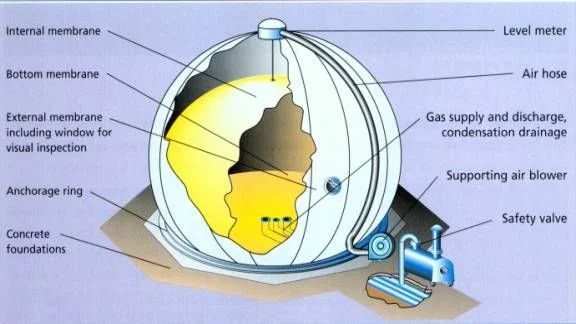BioEnergy Consult: Types of Biogas Storage Systems
The selection of an appropriate biogas storage system makes a significant contribution to the efficiency and safety of a biogas plant. There are two basic reasons for storing biogas: storage for later on-site usage and storage before and/or after transportation to off-site distribution points or systems. A biogas storage system also compensates for fluctuations in the production and consumption of biogas as well as temperature-related changes in volume.
There are two broad categories of biogas storage systems: Internal Biogas Storage Tanks are integrated into the anaerobic digester while External Biogas Holders are separated from the digester forming autonomous components of a biogas plant.
The simplest and least expensive storage systems for on-site applications and intermediate storage of biogas are low-pressure systems. The energy, safety, and scrubbing requirements of medium- and high-pressure storage systems make them costly and high-maintenance options for non-commercial use. Such extra costs can be best justified for biomethane or bio-CNG, which has a higher heat content and is, therefore, a more valuable fuel than biogas.
Low-Pressure Biogas Storage
Floating biogas holders on the digester form a low-pressure storage option for biogas systems. These systems typically operate at pressures below 2 psi. Floating gas holders can be made of steel, fiberglass, or flexible fabric. A separate tank may be used with a floating gas holder for the storage of the digestate and also storage of the raw biogas. A major advantage of a digester with an integral gas storage component is the reduced capital cost of the system.
The least expensive and most trouble-free gas holder is the flexible inflatable fabric top, as it does not react with the H2S in the biogas and is integral to the digester. These types of covers are often used with plug-flow and complete-mix digesters.
Flexible membrane materials commonly used for these gas holders include high-density polyethylene (HDPE), low-density polyethylene (LDPE), linear low-density polyethylene (LLDPE), and chlorosulfonated polyethylene covered polyester. Thicknesses for cover materials typically vary from 0.5 to 2.5 millimeters.
Medium-Pressure Biogas Storage
Biogas can also be stored at medium pressure between 2 and 200 psi. To prevent corrosion of the tank components and to ensure safe operation, the biogas must first be cleaned by removing H2S. Next, the cleaned biogas must be slightly compressed prior to storage in tanks.
High-Pressure Biogas Storage
The typical composition of raw biogas does not meet the minimum CNG fuel specifications. In particular, the CO2 and sulfur content in raw biogas is too high for it to be used as vehicle fuel without additional processing. Biogas that has been upgraded to biomethane by removing the H2S, moisture and CO2 can be used as a vehicular fuel.
Biomethane is less corrosive than biogas, apart from being more valuable as a fuel. Since the production of such fuel typically exceeds immediate on-site demand, the biomethane must be stored for future use, usually either as compressed biomethane (CBM) or liquefied biomethane (LBM).
Two of the main advantages of LBM are that it can be transported relatively easily and it can be dispensed to either LNG vehicles or CNG vehicles. Liquid biomethane is transported in the same manner as LNG, that is, via insulated tanker trucks designed for the transportation of cryogenic liquids.
Biomethane can be stored as CBM to save space. The gas is stored in steel cylinders such as those typically used for storage of other commercial gases. Storage facilities must be adequately fitted with safety devices such as rupture disks and pressure relief valves.
The cost of compressing gas to high pressures between 2,000 and 5,000 psi is much greater than the cost of compressing gas for medium-pressure storage. Because of these high costs, the biogas is typically upgraded to biomethane prior to compression.
To know more, please check BioEnergy Consult.



